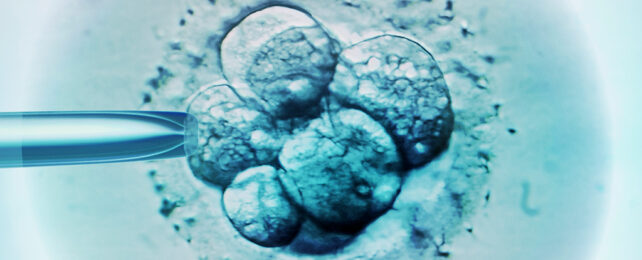At barely a week old, little Bonnie Loutas is already a member of a rather small and exclusive club, joining just a few dozen children around the world conceived through an emerging form of assisted reproductive technology.
It's called capacitation in-vitro maturation (CAPA-IVM), a method that promises to provide prospective parents who are struggling to fall pregnant with an easier, cheaper alternative to the more established process of in-vitro fertilization (IVF).
"We've all been looking forward to seeing this baby come into the world," says Bill Ledger, a fertility specialist at the University of New South Wales.
"The Royal Hospital for Women is one of only six locations in the world to offer CAPA-IVM and this is the first baby conceived here in Australia through this method."
Conventional IVF treatment requires a series of hormone injections to be delivered over the course of two weeks. If all goes accordingly, the body releases one or more ova from their follicles, which are then surgically collected and introduced to sperm outside of the body.
Since the first IVF baby was born in the UK nearly half a century ago, more than 8 million children have been conceived this way.
Yet the procedure still isn't without its shortcomings.
For one thing, the treatment isn't cheap. Nor is it convenient.
It also comes with its own risks, potentially overstimulating the ovaries and causing them to painfully swell. Though uncommon, those with conditions such as polycystic ovarian syndrome (PCOS) can be at higher risk, with more variable responses to hormone treatments.
Rather than collect the isolated ova, IVM takes immature groups of cells called cumulus-oocyte complexes, which contain the immature ova and supportive cells, and allows them to mature outside of the body, reducing the need to stimulate the ovaries into releasing egg cells.
In itself, IVM isn't overly novel. The first child to be conceived from an externally matured ovum was born more than 30 years ago. Some 1,300 children have been conceived using this approach since then.
To improve the procedure, researchers around the world have been exploring ways to improve the outlook for the developing egg.
"The problem has been when you take an egg out of the human body it matures very quickly, even when it may not be ready to, but the CAPA method switches off the progression of the egg for 24 hours. So it grows more slowly, and it matures more healthily," says Ledger.
Healthier eggs means greater chance of a healthy child. And fewer injections means less risk, lower costs, and reduced time spent enduring side effects of the stimulating injections, which can include nausea, headaches, and hot flushes.
As much as it might seem like a minor inconvenience, having to undergo numerous rounds of IVF hormone injection can impose a psychological cost.
For Bonnie's parents, Leanna and Theo Loutas, the opportunity to avoid yet another period of fluctuating hormones at an already busy time of year was too good to pass up.
"I was going to take a break before trying IVF again as I didn't want all of the side effects of the hormones while traveling," Leanna explained.
"When I was offered CAPA-IVM, I was pleasantly surprised to learn that I would only need to do two days of injections. It made the whole process seem a lot less daunting."
